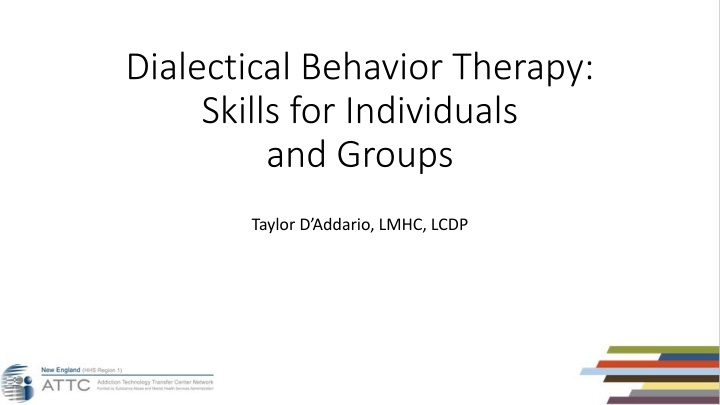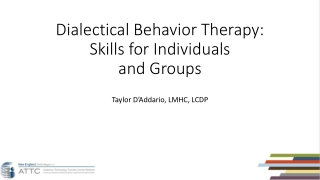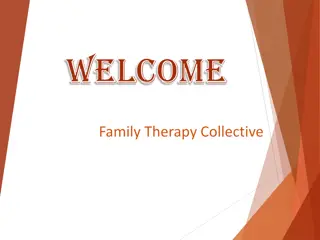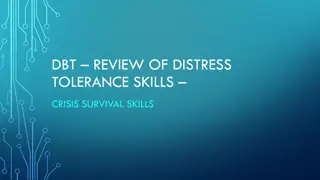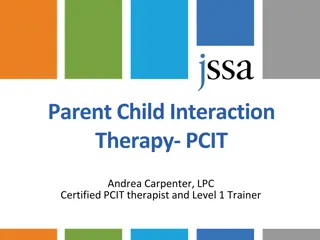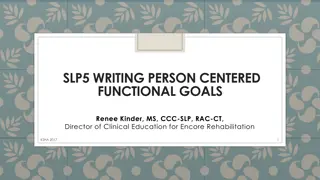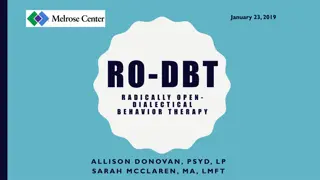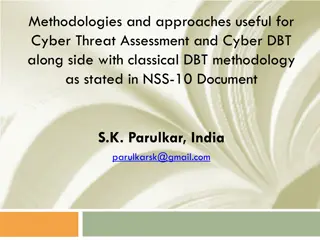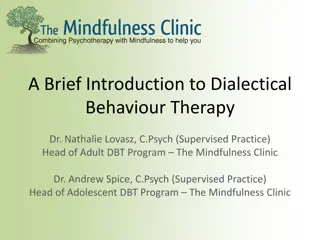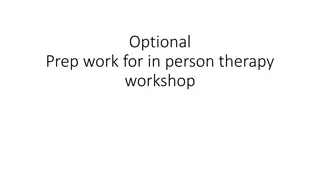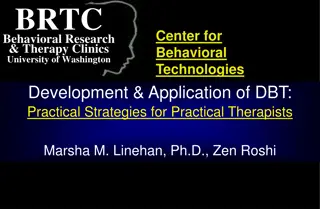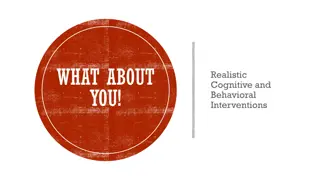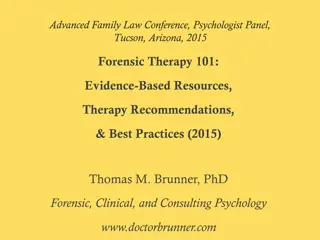Dialectical Behavior Therapy (DBT) Skills and Practices
Explore the foundations of Dialectical Behavior Therapy (DBT) as a treatment for various dysregulation behaviors. Learn about the history, skills, and outcomes associated with DBT, including mindfulness practices and emotional regulation techniques. Discover how DBT combines cognitive behavioral therapy with acceptance and mindful awareness to address a range of issues such as emotion dysregulation, interpersonal difficulties, and self-destructive behaviors.
Download Presentation

Please find below an Image/Link to download the presentation.
The content on the website is provided AS IS for your information and personal use only. It may not be sold, licensed, or shared on other websites without obtaining consent from the author.If you encounter any issues during the download, it is possible that the publisher has removed the file from their server.
You are allowed to download the files provided on this website for personal or commercial use, subject to the condition that they are used lawfully. All files are the property of their respective owners.
The content on the website is provided AS IS for your information and personal use only. It may not be sold, licensed, or shared on other websites without obtaining consent from the author.
E N D
Presentation Transcript
Dialectical Behavior Therapy: Skills for Individuals and Groups Taylor D Addario, LMHC, LCDP
Disclosures The development of these training materials were supported by grant H79 TI080209 (PI: R. Martin) from the Center for Substance Abuse Treatment, Substance Abuse and Mental Health Services Administration, United States Department of Health and Human Services. The views and opinions contained within this document do not necessarily reflect those of the US Department of Health and Human Services, and should not be construed as such.
Grounding Exercise 5,4,3,2,1 What is mindfulness?
Welcome Your Name Your Job/Agency What You Hope To Learn Today How Familiar Are You With DBT ( 1-10 )
Goals of Todays Training Learn DBT skills for yourself Learn how to use DBT with clients Learn how to facilitate a DBT skill building group Learn about the DBT manual Learn about what behaviors DBT treats
Dialectical Behavioral Therapy History Developed in the 1980 s by Marsha Linehan Originally used to treat Borderline Personality Disorder Combines standard CBT with emotional regulation, distress tolerance, acceptance and mindful awareness
What Behaviors Does DBT Treat Emotion Dysregulation Affective lability, intense anger Interpersonal Dysregulation Fear of abandonment, idealization, & devaluation Behavior Dysregulation Suicidal behaviors, other self-injurious behaviors, & impulsivity Self Dysregulation Emptiness, identity disturbance Cognitive Dysregulation Dissociation & paranoia
Typical DBT Outcomes Suicidal attempts, self-injury Substance misuse, binge-eating disorder Hospitalizations, emergency-care Drop-out from treatment Anger & hopelessness Social adjustment & self-esteem Costs of treatment
DBT Bio-Social Theory Biologically- Based Emotion Sensitivity & Impulsivity Severe & Pervasive Emotional Dysregulation Pervasively Invalidating Environment
Set Up The Group Every client should have a notebook with handouts and assignment Have extra pen & paper available Sit around a table Use a white board, black board or flip chart Behavior, and elicit behavior, appropriate for a classroom setting
3 1 The 4 Modules 2 4
ORIENTATION TO SKILLS TRAINING (General Handout # 1) Mindfulness: the practice of being fully aware and present in this one moment. Distress Tolerance: how to tolerate pain in difficult situations, not change it. Emotion Regulation: how to change emotions that you want to change. Interpersonal Effectiveness: how to ask for what you want and say no while maintaining self-respect and relationships with others.
ORIENTATION TO SKILLS TRAINING (General Handout # 1) In the group context, explain the purpose of the first session is to introduce members to one another and to the skills training leaders. Ask each participant to introduce herself with her name and a statement of why the member is here. Leaders: introduce yourself and give information about yourself and why you are leading skills training. Orient members to the structural aspects of the therapy (e.g. format, rules, and meeting times).
ORIENTATION TO SKILLS TRAINING (General Handout # 1) 1. 2. 3. 4. Mindfulness skill Homework review Teach new skill(s) Lesson summary and assignment of homework
ORIENTATION TO SKILLS TRAINING (General Handout # 1) Describe order and length of modules Describe use of session time (1/2 for homework practice 1/2 for learning new skills) Make it clear that neither time or format allows for discussion of personal problems unrelated to using behavioral skills Discuss use of telephone calls to skills trainer
ORIENTATION TO SKILLS TRAINING (General Handout # 1) Goals of skill training Practice commitment (practice, practice, practice)
GUIDE LINES FOR SKILLS TRAINING (General Handout #3) Group Agreements Sets boundaries
SKILLS TRAINING ASSUMPTIONS (General Handout # 4) People are doing the best they can People want to improve People Need to be better, try harder and be more motivated to change People may not have caused all their own problems. But they have to solve them anyway New behaviors must be learned in all relevant contexts All behaviors (actions, thought, emotions) are caused Figuring out and changing the causes of behaviors work better than judging and blaming
Modules Teaching Notes Client Handouts Client Worksheets (for homework)
Module Handouts Teaching Notes: Model of Emotions (Emotion Regulation Handouts (5-6) Handouts: Emotion Regulation Handout 5 (Emotion Regulation Worksheets 4, 4A) Worksheets: Emotion Regulation Worksheet 4, 4A (Emotion Regulation Handouts 5,6 )
CORE MINDFULNESS: GOALS (Mindfulness Handout # 1) To get in control of your mind By enhancing awareness By strengthen attention By increasing presence Not by controlling the contents of your mind To find and activate WISE MIND
EMOTION MIND Hot Mind Mood-dependent mind When the mind is driven by emotions Emotion mind is exaggerated by: Imbalances in sleep, eating, exercise Stress, loss, disruption Poor self care re: medical problems Some psychotropic medications
REASONABLE MIND Cool mind Logical Mind Task-focused mind Useful for soling a million logical problems: Planning, timing, travel, sequencing Predicting outcomes, weighing probabilities Finances, logistics By itself, can be too dry, colorless
WISE MIND (Mindfulness Handout # 1) Difficult to describe True self , Center , Intuitive , Spirit Each client must discover wise mind through life examples A central aim of core mindfulness skills in DBT is to locate and activate wise mind Wise Mind is a synthesis of Emotion Mind and Reasonable Mind
Getting to Wise Mind Wise Mind Reasonable Mind Emotion Mind
Case Example: Pick 1 Tanya was at a party when a friend passed her a bottle of beer. She thought everyone else is drinking. Will they accept me if I don t? Then she remembered that she had an important exam on Monday; she realized she wouldn t study well the next day if she got drunk that night, so she said, No thanks.
Case Example: Pick 1 Joe needs to take a bus to his dentist appointment next week at 2:30pm. Joe figured that he could stand at his bus stop at 2:00pm and hope that a bus shows up. But instead Joe looked up the bus schedule online to plan his bus ride so he gets to his dentist appointment on time next week.
Case Example: Pick 1 Makenna was shopping for a specific jacket she saw online at Macys.com. When Makenna got to the store the sales person informed her that they were sold out. Makenna snapped at the sales person, yelling and screaming at them for ruining her life.
Case Example: Pick 1 Catherine was sitting in class when a classmate tripped and knocked over her waterbottle spilling water all over the floor. Catherine was angry and embarrassed and wanted to punch her classmate for spilling her water. Catherine realized she didn t want to create problems with her classmate so she went over to the sink to grab paper towels to help clean up.
TEACHING CORE MINDFULNESS SKILLS After helping each client find Wise Mind Teach that there are six skills to Wise Mind . Three What Skills (what you do) Observe, Describe, Participate Three How skills (how you do what you do) Non-judgmentally, One-mindfully, Effectively
OBSERVE (Mindfulness Handout #4) Just noticing exactly what is Being like a guard at the place gate Alert to everything that comes and goes Having a Teflon Mind Just noticing without labeling, interpreting, judging, or finding patterns Children do it all the time (looking at sky, water, fire, bugs, etc)
DESCRIBE (Mindfulness Handout #4) Adding a label to an observed experience Putting words on experience Noting Just the facts You cannot describe something unless you observe it; be aware of assumptions You cannot observe another person s thoughts, emotions, or intentions
PARTICIPATE (Mindfulness Handout #4) To enter completely into what you are doing in the present moment Responding spontaneously, without ruminating, without self- consciousness Engaging completely, with immersion Being in the zone , being one with the activity; no boundary between self and activity
NON-JUDGMENTAL (Mindful Handout #5) See reality exactly as it is, without judging it as either good or bad Notice judgments as judgments, facts as facts Evaluate, by discriminating and measuring, but without adding on judgments Judgments are compact statements condensing valid events, reactions, consequences
ONE-MINDFULLY (Mindfulness Handout #5) To do one thing at a time, with awareness Bring your entire attention to this one moment When overwhelmed by many things simply do one thing at a time, with total focus Wash the dishes, one at a time, to wash the dishes (Thich Nhat Hanh)
EFFECTIVELY (Mindfulness Handout #5) To use skillful means Focus on what works Not what is right versus wrong Play by life s rule, just do what s needed Keep an eye on your goals and your values It sometimes means letting go of your ego
Diary Card- Practice Makes Perfect Progress To be completed every day Review skills monitoring only
DISTRESS TOLERANCE SKILLS Getting through a painful moment without making things worse.
DISTRESS TOLERANCE: Overview of Module Goals of the Module When to Use Crisis Survival Strategies vs. Reality Acceptance Skills Crisis Survival Skills Reality Acceptance Skills
GOALS OF THE MODULE (Distress Tolerance Handout #1) Survive Crisis Situation w/o Making Them Worse Accept Reality As It is In The Moment Become Free When we are free, we can look in the face of distress, cravings, and desires Pain and distress are a part of life Try to get rid of them can increase suffering
WHEN TO USE CRISIS SURVIVAL SKILLS When intense pain or problems that can t be helped quickly When acting on emotion mind would make things worse When emotional distress threatens to be overwhelming When feeling overwhelmed but needing to meet demands
CRISIS SURVIVAL STRATEGIES (Distress Tolerance Handout #2) The STOP Skill Pros and Cons TIPS Skills, for Changing Body Chemistry Distracting Skills Self-Soothing Skills Improving the Moment Skills
CRISIS SURVIVAL SKILLS (Distress Tolerance Handout #4) The STOP Skill Stop When emotions are about to take control, freeze! Take a Step Back Take a step back physically or in your mind; get unstuck Observe What is happening inside and around you Proceed Mindfully Ask Wise Mind how to deal with the problem
PROS AND CONS (Distress Tolerance Handout #5) Main Goal: To learn that accepting reality & tolerating distress leads to better outcomes than rejecting reality and refusing to tolerate When to Use Pros and Cons: Compare pros and cons of different people Helps to resist impulsive or destructive urges
Pros And Cons: How to Thinking of Pros and Cons When in distress, and considering engaging in a problem behavior (cutting, drugs, purging, etc.) List the pros and cons of acting on crisis urges; then List the pros and cons of resisting crisis urges While doing pros and cons notice Positive long term consequences of tolerating Versus negative consequences of using the problem behavior for short term relief
Example: Pros and Cons of Self-Cutting Pros Cons Reduce tension Reduce negative emotions Get support Show misery externally Scars diminish Others approve Move towards goals Increase positive feeling; pride Scars Alienate others Self hatred Sense of failure Distress remains Other behaviors are not as effective in short run Can t function as well in the moment Self- Cutting Resisting Cutting
Further Teaching Points: Pros and Cons Rehearse pros and cons multiple times Review earlier pros and cons that have been written down It can be difficult to do it in emotional mind Say NO to crisis urges (out loud) when over whelming emotions hit E.g., NO! There s no going back! .
TIP SKILLS TO MANAGE EXTREME AROUSAL (Distress Tolerance Handout #6) Rapid ways to reduce arousal when very high Work within seconds to minutes 4 Skills Temperature Use of cold water on face to elicit diver response Intense Exercise Paced Breathing Paired Muscle Relaxation
